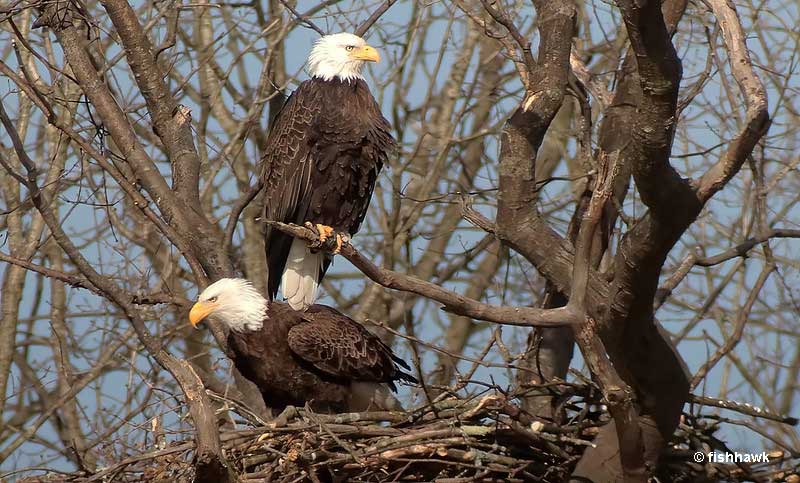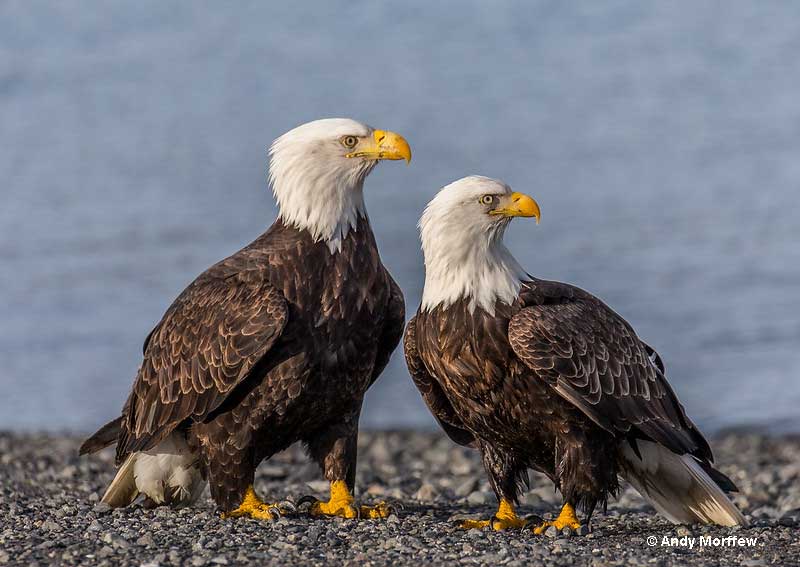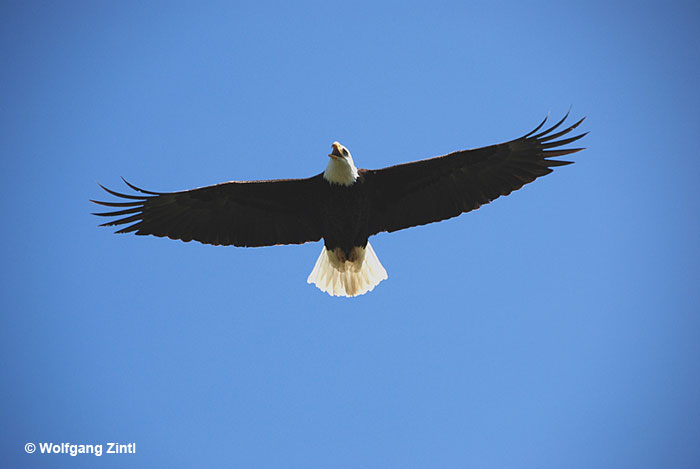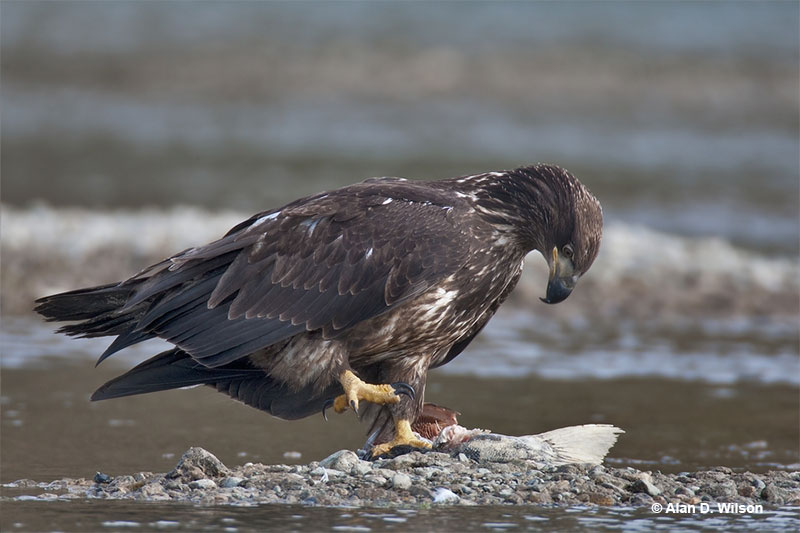
The Bald Eagle has been a symbol of the American nation ever since the 18th century. Considering its majestic appearance, it is no wonder that the European settlers were so impressed with the immense, white-headed (not actually bald, but “piebald”), fish-eating raptor that they put it on the State Seal.
The fascination remains up to this date. Luckily, drastic conservation actions saved the Bald Eagle from the looming 20th-century extinction; now, it abundantly flies over lakes, rivers, and coasts – its main habitats.
We know that the Bald Eagles are huge – but just how huge?
Let’s explore the stats and get a better impression of how large the Bald Eagle is and how it compares to other giant raptors.
On this page
How Big Are Bald Eagles?
Bald Eagles are one of the largest raptor species in North America and beyond.
Data on size varies, but here are some average numbers:
- Height/length: 28 to 38 inches
- Wingspan: 5.5 to 8 feet
- Weight: 10-15 lbs for females, 6 to 9 lbs for males. The greatest historical record was 18 lb, but can’t be verified.
Female eagles are typically about 25% larger and have slightly wider wingspans than males. Additionally, birds found in northern regions tend to be larger than those in the southern areas. Alaskan population of Bald Eagles has the bulkiest recorded individuals.

Judging by the size, female is on the left and male is on the right.
How Do Bald Eagles Compare To Other U.S Eagles?
The Bald Eagle is definitely in the top 3 of the largest North American eagles and is sometimes considered the largest. However, many sources cite the Golden Eagle as the biggest one, even though the quoted measurements often favor the Bald Eagle.
Related: Types of eagles (around the world)
I would conclude the debate peacefully by saying that Bald Eagles and Golden Eagles are a close contest – so close that we can’t precisely tell who’s bigger. Their measurements are simply too similar to make a definite judgment.
How Big Are Bald Eagles Compared to Humans?
The average median adult human height is around 5’10” for men and 5’4″ for women. With a maximum 34-inch body length, the Bald Eagle is no match for the height of an adult human.
The largest Bald Eagles match the height of a 2-3-year-old human child, which is precisely around 34 inches. Still, with an average weight of 26 lbs or more, a toddler would definitely outweigh a Bald Eagle. To be able to fly, birds have hollow bones, so they are lighter than mammals and humans of the same height.
However, the immense wingspan of Bald Eagles, with a maximum of 7’6″ to 8′, surpasses even the tallest individuals of our kind.
The currently tallest NBA player, Boban Marjanović, is 7’4″ tall and would be a close match to a Bald Eagle’s maximum wingspan (only on a different axis!)
The only people to outmatch that length would be individuals with true gigantism, such as Robert Pershing Wadlow, aka the Giant of Illinois (1918 – 1940). Standing at 2.72 m (8 ft 11.1 in), he was the tallest man ever reliably recorded.
How Big Are Bald Eagles Compared To Other Birds?
The Bald Eagle is always in the top 10 of the world’s biggest eagles. Still, there are other eagle species that are both longer, heavier, and have bigger wingspans than the popular “American Eagle.”

Here are some examples of size differences between the Bald Eagle and the others (we’re comparing the maximum measurements).
- The Steller’s Sea Eagle is heavier than the Bald Eagle (up to 22 lbs)
- The Philippine Eagle is taller than the Bald Eagle (up to 3.35 ft)
- The Wedge-Tailed Eagle is one of the eagles with a bigger wingspan than the Bald Eagle (9 ft 4 in).
Learn more: The Most Interesting Bird Facts & Stats
Outside of the eagle realm, there are other birds that outmatch the Bald Eagle in terms of maximum measurements.
- The Wandering Albatross has the largest wingspan in the bird world, measuring 11.5 feet; the Bald Eagle’s wingspan is more than a meter shorter!
- The Common Ostrich is by far the world’s tallest and heaviest bird; it can reach a height of up to 29 feet and weigh up to 287 lbs!
- The Sarus Crane is the world’s tallest flying bird, standing at 152-156 cm.
- The Kori Bustard (males) weigh 24-42 pounds, making it the world’s heaviest flying bird.
Who Is The Largest Eagle In The World?
The question of which eagle is the largest in the world is common but tricky.
The most typical answer is that it is the Philippine Eagle. Besides being large, this eagle is undoubtedly beautiful – its trademark contrasting plumage forms a “crown” on the head. It is endemic to the Philippines.
Unfortunately, it is also one of the world’s most endangered raptors due to habitat loss and shooting. Scientists estimate that only 200-500 of these birds remain in the wild.
Regarding size, the Philippine Eagle has an impressive length (or height, if you want) of up to 3.35 ft, can weigh up to 17.6 lbs, and has a maximum wingspan of 6.56 ft.
I’ve Heard Other Eagles Are Bigger Than the Philippine Eagle – What’s That All About?
It is important to note that not a single eagle species is the “largest” in every aspect. The Philippine eagle is the biggest in length and wing surface area, but the Steller’s Sea Eagle and the Harpy Eagle outmatch it in weight and bulk.

Also, you’ve probably noticed that the Bald Eagle, as well as the Golden Eagle and the White-Tailed Eagle, all have larger wingspans and that the Bald Eagle is even longer by some sources.
That is why not all authorities agree on the question of the largest eagle. For example, the Steller’s Sea Eagle is considered the biggest by the Guinness Book of World Records.
Fun Facts About Bald Eagles
- The Latin name of the species, ‘Haliaeetus leucocehalus,’ translates to “white-headed sea eagle” – pretty much on the spot!
- The Bald Eagle became the United States’ official national symbol in 1782 after a long and tedious work on the Great Seal of the United States. Benjamin Franklin wrote to his daughter that he thought the bald eagle was “a bird of bad moral character” and thus unfit for the purpose.
- Franklin likely based his negative stance on the fact that Bald Eagles often scavenge dead fish and mammals (even roadkill) and bluntly steal fish from Ospreys and other avian fish-eaters.
- Bald Eagle’s keenest sense is its full-color vision, its main weapon when seeking prey.
- This eagle is also an amazing flyer, achieving active flight speed of 20-40 mph, diving at 75-100 mph, and soaring for hours by utilizing wind currents and thermal updrafts. The wide wingspan enables eagles to conserve precious energy when hunting.
- Bald Eagles are strictly monogamous and are thought to mate for life – at least until one of the partners dies.
- The size records in bald eagles do not end with body size. Bald Eagle pairs build huge nests. The largest nest was discovered in Florida; it weighed 2 tons, measured 9 feet across, and was 20 feet deep!
- The average lifespan (that is, the median life expectancy) of a Bald Eagle is 16.5 years.
Bald Eagle Status – Are Bald Eagles Endangered?
Currently, Bald Eagle is officially listed as Non Threatened, but the story behind the status is dramatic.
Despite being abundant when the United States was founded, Bald Eagles suffered a major decline in the 20th century. Shooting (sometimes with bounties), habitat modification, and use of DDT and lead ammunition all caused the population to plummet. In 1963, there were only 417 pairs left!

Juvenile bald eagle enjoying a meal
Still, the Bald Eagle population made an amazing turn-around. It was placed on the endangered species list in 1973. The notorious insecticide DDT and lead for waterfowl hunting were banned, the nesting habitats were protected, and there were hefty fines and jail time for killing Bald Eagles. Consequently, the population in the lower 48 states increased to 316,700 birds, according to 2019 data.
Read more: How did Bald Eagles beat the odds?
The return of the Bald Eagle is one of the most successful conservation stories in U.S. history. The bird was removed from the Endangered Species list in 2007, but federal and state laws still protect it.
Frequently Asked Questions
How big is a Bald Eagle compared to a human?
Bald Eagles (females) have a body length of 71 to 86 cm. When standing upright, their heads would reach an average person’s thigh or hip.
The maximum height recorded for Bald Eagles matches the size of a 2-3-year-old human, which is precisely around 86 cm. However, with an average weight of 12 kg or more, a toddler of that age and height would definitely outweigh even the heaviest female Bald Eagles, whose maximum is a bit under 7kg. Bald eagle males weigh up to 4 kg – like a chunkier human newborn!
However, the immense wingspan of Bald Eagles, with a maximum of 2.3-2.44 meters, surpasses most humans, with a global average height of 175 cm for men.
How big is the biggest Bald Eagle?
The heaviest Bald Eagle on record was supposedly shot in 1876 in Wyoming County, New York. This giant reportedly measured 18 lbs. The case was written down by Ralph S. Palmer in his Handbook of North American Birds, but it is impossible to verify the findings from such a long time ago with modern measurement techniques.
How big of an animal can a Bald Eagle pick up?
Like most large eagles, Bald Eagles prefer medium-sized prey. The largest recorded fish they actively caught measured up to 75 cm, but they preferred to take fish around 36 cm long on average.
Live land animals comprise a significantly smaller part of the Bald Eagle’s diet (which mostly consists of fish and carrion). Still, they will opportunistically feed on mammals and reptiles, too. While they prefer animals the size of a rabbit, Bald Eagles occasionally catch fawns and calves, especially if near water.
Are Bald Eagles aggressive to humans?
Bald eagles have been known to attack humans, albeit rarely. Also, the attacks were always non-lethal. In 2020, one such attack in Minnesota was caught on camera and shows a juvenile Bald Eagle grabbing and pecking at a woman’s leg. The eagle was restrained and took off later, and the woman suffered only minor injuries.
Also, adult Bald Eagles may become more territorial – and thus aggressive – during the nesting season.
There are many historical accounts of Bald Eagles attacking humans, especially children, but these are hard to prove or disprove. Note that these accounts often ended fatally for Bald Eagles, which were legally hunted until 1940, and killing them was even encouraged at times.
Raptors are very powerful wild birds. Accordingly, you should always keep a safe distance and respect their space. Please resist mocking or playing games with nearby eagles and teach kids the same. If an eagle seems to be going for you, the best option is to put your hands up and make yourself look as big as possible (the birds themselves often apply this strategy!) while calling out for help.
